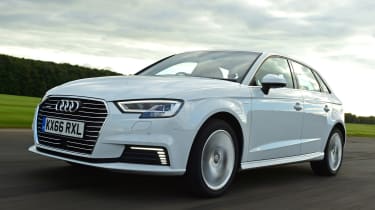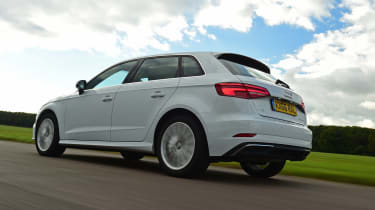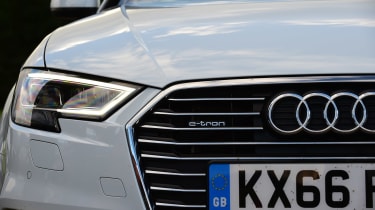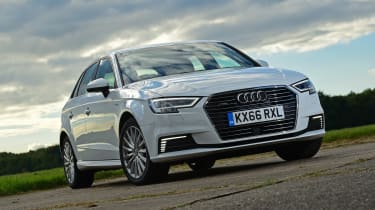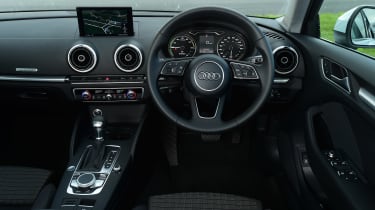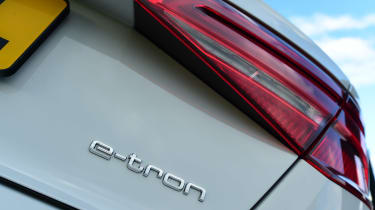Audi A3 e-tron (2014-2018) review
The Audi A3 Sportback e-tron hybrid offers all the usual Audi refinements with a tax-efficient ‘green’ tinge
The A3 Sportback is a popular five-door hatchback based on the Volkswagen Golf, and it also takes on premium-badged competitors such as the BMW 1 Series and the Mercedes A Class. It comes with a wide variety of powertrains from frugal diesels and efficient petrol engines, to the high performance S3 and RS 3 models. The e-tron offers something a little different though, as it’s the only hybrid in the A3 line-up.
It’s a plug-in hybrid in fact, and features a 75kW electric motor mated to a 1.4-litre TFSI petrol engine and a six-speed S Tronic dual-clutch auto gearbox. The battery is an 8.8kWh unit and it lives under the boot floor, significantly reducing load capacity. The hybrid engineering also adds a fair chunk of weight to the car, mostly thanks to the battery pack which tips the scales at 125kg.
It’s hard to tell an e-tron from a standard A3 Sportback at a glance, unless you recognise the model’s unique grille trim finish. It has evenly spaced shiny chrome slats, while regular A3s have grille slats that are bunched up in pairs without the brightwork. The Audi rings on the grille slide sideways to reveal a charging socket, too, allowing you to connect your e-tron to the National Grid in your garage or at a public charging station. The e-tron also has a distinctive ‘light signature’ thanks to extra LED running lights beneath the headlamps in the bumper grille openings.
More reviews
Car group tests
In-depth reviews
Road tests
Used car tests
Inside there’s not much to signify the e-tron spec either, apart from a bespoke instrument cluster. You do get sports seats, which are a nod to the car’s performance potential, and the high purchase price also means the top level MMI system is fitted – with Navigation Plus and a large retractable display screen.
The kit tally also includes 17-inch alloy wheels, Audi Drive Select, dynamic suspension and a 7.5-metre charging cable.
The Audi A3 Sportback is an alluring choice, and the added plug-in hybrid technology of the e-tron model could make it even more attractive to drivers with a large-ish company car budget. It’s a decent enough drive with a good turn of speed and the usual Audi comfort and refinements, but with battery-only range limited to 29 miles many owners will find themselves relying mostly on the 1.4 TFSI petrol engine as there’s no on-board charging mode to top up the cells when you’re driving. Boot space is reduced significantly by the battery pack, and the extra weight cuts back on the driving fun. So unless you’re after the company car tax benefit-in-kind savings, we’d recommend other models in the Sportback range before the e-tron.
Engines, performance and drive
The Audi A3 Sportback is not the most engaging driver’s car. The e-tron variant does benefit from standard-fit dynamic suspension, and feels surefooted and brisk. But as a driver you’re always aware of the extra weight in the car. Steering feel is lacking, and while response to wheel inputs is quick and direct, compared to the standard Sportback, the heavier e-tron can feel a little less wieldy and a bit less sharp to turn in.
Like all Audi A3 models, the suspension is firm and not as supple as the best in class. But the body is well controlled, and if you tackle a B-road with gusto the car feels safe and composed. There’s plenty of grip too, but while it’s possible to drive the e-tron quickly from A to B, that underlying sense of inertia means it’s not a particularly engaging experience.
Most people buying an e-tron will be looking for the economy advantages the hybrid powertrain offers, so will very likely be satisfied with the experience. Driven moderately, the car performs very well.
Engines
The 1.4-litre TFSI engine is a turbocharged petrol unit that makes a handy 148bhp, and when you add the extra power from the electric motor the total 201bhp output sounds pretty serious. Unfortunately, the extra weight of the batteries means the e-tron weighs-in at 1,540kgs and this has a dampening effect on performance. The 0-62mph time is respectable at 7.6 seconds, but from the driver’s seat it never quite feels that quick.
The dual-clutch auto gearbox is generally smooth, but when the battery is low on juice it can get a bit clunky when transitioning between electric or petrol drive. The latest e-tron doesn’t have a petrol charging mode, so you’re reliant on whatever you put in the batteries when plugged in, and the bit of energy you can recoup through regenerative braking or when coasting.
A full plug-in charge should allow you 29 miles in electric mode, while a Hybrid setting manages battery and petrol power to maximise efficiency. The final setting, Hybrid Hold, conserves the battery for use later – in a city, for example. The petrol engine also has cylinder deactivation technology, to further improve efficiency.
MPG, CO2 and Running Costs
The Audi A3 Sportback e-tron is a great choice for company car drivers, who qualify for very advantageous Benefit-in-Kind (BIK) rates of just nine per cent – even though the model costs a hefty £35k+ to buy. That’s because plugged-in and fully charged, the e-tron has a claimed CO2 output of just 38g/km and the potential to achieve 166.2mpg.
Of course if you’ve used up the battery charge by driving emissions-free on electric power (for up to 29 miles, depending on driving style), the consumption and CO2 figures will be considerably higher. But the taxman doesn’t seem to mind that. When you’re driving mostly with the petrol engine, it seems reasonable to assume fuel economy will be similar to the standard A3 1.4 TFSI. It uses the same cylinder deactivation tech, and Audi claims it will return over 60mpg on the combined cycle while emitting 105g/km of CO2.
Whatever the realities of your day to day motoring, the e-tron’s official figures mean a 20 per cent taxpayer will have an annual BIK bill of £646, while a 40 per cent taxpayer will have to cough up £1,292. By comparison, drivers of a regular 1.4 TFSI model listed at around £25k would pay £1,077 or £2,154 respectively depending on their tax band.
The news isn’t quite as good for employers – or indeed individuals buying the car privately. That’s because the predicted residual values are considerably lower for plug-in and EV models, which means overall cost of ownership could be higher than for a petrol or diesel alternative.
Insurance groups
The Audi A3 Sportback e-tron has a high insurance rating that reflects its relatively rapid acceleration. It comes in at group 33.
Depreciation
While the Audi A3 e-tron seems likely to avoid the worst ravages of electric car depreciation, it’s unlikely to perform as well as one of its non-hybrid sister models. Expect to see values fall to around 30 per cent of the new price after three years/30,000 miles and you shouldn’t be too far off the money.
Interior, design and technology
Apart from the unique grille, there’s little to distinguish the e-tron version of the A3 Sportback from its stablemates, and that’s not necessarily a bad thing. The handsome five-door five-seater gets its name from an almost estate car-like rear that looks good and is practical too. Audi doesn’t offer its e-tron powertrain package in the three-door A3, the Saloon version or the Cabriolet.
Inside, there’s little to mark it out either, apart from the bespoke instrument pack, which is tailored to the hybrid drive system. The main instrument binnacle contains two large dials, with the speedo on the right. There’s no rev-counter, but instead the left-hand dial measures percentage power output. There’s a colour information display between the dials that delivers crucial powertrain info, and you can also pay to upgrade the instrument pack to the Audi Virtual Cockpit. It’s an impressive 12.3-inch digital cluster that shows everything from satnav mapping to entertainment functions and MMI/vehicle settings.
Otherwise, the interior is standard A3, which means it’s good looking, beautifully built and a useful benchmark for quality for cars several classes up.
Sat-nav, stereo and infotainment
Whether you opt for the Virtual Cockpit or not, the A3 Sportback e-tron provides an excellent infotainment set-up with its standard fit MMI Navigation Plus system and seven-inch colour display that pops up from the top of the dash.
MMI operates via a touchpad that allows you to zoom around the maps, and use intuitive menus for audio and car settings. It even has a handwriting recognition function. The sat-nav itself has 3D mapping and dynamic route guidance, and the audio set-up includes a 10GB jukebox hard drive, and a DVD drive. You can upgrade the standard audio to a 10-speaker arrangement for £255, while a 705-watt 14-speaker Bang & Olufsen upgrade costs £750.
Practicality, comfort and boot space
There’s no doubt the interior of any Audi A3 is a nice place to be. The seats and steering wheel offer masses of adjustment, and it’s easy to find a suitable driving position. There’s an impression of refinement and quality that does wonders for your feel-good factor, too. The ride quality can seem a little under par, but it’s never an issue that degrades the on-board experience to the point of actual discomfort.
Size
The e-tron is only available in the Sportback bodystyle, which is at 4,312mm long is 71mm longer than the three-door A3. Much of the extra length goes into the rear cabin, and the Sportback shape gives you precious extra millimetres of headroom too.
Leg room, head room & passenger space
While front-seat occupants could easily imagine themselves in any one of the A3 variants, it’s a different story for those in the back – where the e-tron’s extra legroom and rear doors are a boon.
But it’s not all good news as the Sportback feels relatively narrow inside and three adults on the rear bench will feel cramped. There’s a transmission tunnel and bulky console for the centre occupant’s feet to contend with, while the bench squab itself is higher in the centre, possibly causing headroom issues. There’s no ISOFIX mounting for child seats on the centre seat either.
Boot
While the e-tron powertrain doesn’t affect cabin space for occupants, unfortunately the same cannot be said of the boot. The requirement to store a battery under the floor means volume is reduced by 100 litres to just 280 litres. That’s smaller than many superminis.
Reliability and Safety
The Audi A3 was awarded above average marks for reliability and build quality in the 2017 Driver Power survey, although a relatively high proportion of owners – 13.6 per cent – told us they’d had at least one fault with their car in its first year.
While much of the technology is carried straight over from petrol and diesel models, the e-tron’s hybrid nature adds a level of complexity, which could impact that fault rate. Either way, the Audi brand as a whole was rated 17th out of 27 manufacturers, which isn’t brilliant for a manufacturer that sells itself as a premium offering.
Safety is a bit more of a known quantity, as the A3 Sportback e-tron has been specifically tested by Euro NCAP – separately to the mainstream models. It earned the full five stars, and there’s no doubting the array of safety technology available on the e-tron. It comes equipped as standard with autonomous emergency braking with pedestrian recognition, seven airbags and lane keeping alerts. A £500 Driver Assistance package adds adaptive cruise control, active lane assist, traffic sign recognition and a parking camera.
Warranty
The standard Audi three-year/60,000-mile warranty applies to all A3s, which is a bit meaner than the unlimited mileage offers from BMW and Mercedes. There’s an additional eight-year/100,000-mile warranty against battery failure on e-tron models. Audi reckons battery degradation of between 10 and 30 per cent of capacity counts as ‘normal wear and tear’, though, so that’s something to watch out for.
Servicing
There are only a relative handful of Audi dealers who can supply and service e-tron models – 34 in total. If you don’t have one nearby it could make routine and other maintenance a bit of a pain. Costs shouldn’t be too much higher than for a regular petrol or diesel model though.
For an alternative review of the latest Audi A3 e-tron SUV visit our sister site carbuyer.co.uk
